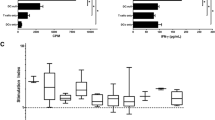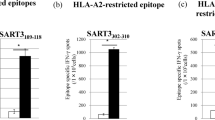Abstract
Survivin is a tumor-associated antigen (TAA) that has significant potential for use as a cancer vaccine target. To identify survivin epitopes that might serve as targets for CTL-mediated, anti-tumor responses, we evaluated a series of survivin peptides with predicted binding to mouse H2-Kb and human HLA-A*0201 antigens in peptide-loaded dendritic cell (DC) vaccines. H2-Kb-positive, C57BL/6 mice were vaccinated using syngeneic, peptide-loaded DC2.4 cells. Splenocytes from vaccinated mice were screened by flow cytometry for binding of dimeric H2-Kb:Ig to peptide-specific CD8+ T cells. Two survivin peptides (SVN57–64 and SVN82–89) generated specific CD8+ T cells. We chose to focus on the SVN57–64 peptide because that region of the molecule is 100% homologous to human survivin. A larger peptide (SVN53–67), containing multiple class I epitopes, and a potential class II ligand, was able to elicit both CD8+ CTL and CD4+ T cell help. We tested the SVN53–67 15-mer peptide in a therapeutic model using a peptide-loaded DC vaccine in C57BL/6 mice with survivin-expressing GL261 cerebral gliomas. This vaccine produced significant CTL responses and helper T cell-associated cytokine production, resulting in a significant prolongation of survival. The SVN53–67 vaccine was significantly more effective than the SVN57–64 core epitope as a cancer vaccine, emphasizing the potential benefit of incorporating multiple class I epitopes and associated cytokine support within a single peptide.







Similar content being viewed by others
References
Giese A, Westphal M (2001) Treatment of malignant glioma: a problem beyond the margins of resection. J Cancer Res Clin Oncol 127:217–225
Halperin EC, Burger PC, Bullard DE (1988) The fallacy of the localized supratentorial malignant glioma. Int J Radiat Oncol Biol Phys 15:505–509
Stupp R, Mason WP, van den Bent MJ et al (2005) Radiotherapy plus concomitant and adjuvant temozolomide for glioblastoma. N Engl J Med 10:987–996
Altieri DC (2003) Validating survivin as a cancer therapeutic target. Nat Rev Cancer 3:46–54
Adida C, Crotty PL, McGrath J et al (1998) Developmentally regulated expression of the novel cancer anti-apoptosis gene survivin in human and mouse differentiation. Am J Pathol 152:43–49
Kajiwara Y, Yamasaki F, Hama S et al (2003) Expression of survivin in astrocytic tumors. Cancer 97:1077–1083
Sasaki T, Lopes MB, Hankins GR, Helm GA (2002) Expression of survivin an inhibitor of apoptosis protein in tumors of the nervous system. Acta Neuropathol (Berl) 104:105–109
Chakravarti A, Noll E, Black P et al (2002) Quantitatively determined survivin expression levels are of prognostic value in human gliomas. J Clin Oncol 20:1063–1068
Islam A, Kageyama H, Takada N et al (2000) A high expression of survivin mapped to 17q25 is significantly associated with poor prognostic factors and promotes cell survival in human neuroblastoma. Oncogene 19:617–23
Andersen MH, Pedersen LO, Capeller B et al (2001) Spontaneous cytotoxic T-cell responses against survivin-derived MHC class I-restricted T-cell epitopes in situ as well as ex vivo in cancer patients. Cancer Res 61:5964–5968
Fenstermaker RA, Ciesielski MJ (2004) Immunotherapeutic strategies for malignant gliomas. Cancer Control 11:181–191
Ciesielski MJ, Apfel L, Barone TA, Castro CA, Weiss TC, Fenstermaker RA (2006) Antitumor effects of a xenogeneic survivin bone marrow derived dendritic cell vaccine against murine GL261 gliomas. Cancer Immunol Immunother 55:1491–1503
Rammensee HG, Bachmann J, Emmerich NN, Bachor OA, Stevanovic S (1999) SYFPEITHI: database for MHC ligands and peptide motifs. Immunogenetics 50:213–219
Kmieciak D, Bednarek I, Takiguchi M, Wasik TJ, Bratosiewicz J, Wierzbicki A, Teppler H, Pientka J, Hsu SH, Kaneko Y, Kozbor D (1998) The effect of epitope variation on the profile of cytotoxic T lymphocyte responses to the HIV envelope glycoprotein. Int Immunol 10:1789–99
Gordan JD, Vonderheide RH (2002) Universal tumor antigens as targets for immunotherapy. Cytotherapy 4:317–27
Altieri DC (2003) Survivin and apoptosis control. Adv Cancer Res 88:31–52
Altieri DC (2001) The molecular basis and potential role of survivin in cancer diagnosis and therapy. Trends Mol Med 7:542–7
Andersen MH, Pedersen LO, Becker JC, Straten P (2001) Identification of a cytotoxic T lymphocyte response to the apoptosis inhibitor protein survivin in cancer patients. Cancer Res 61:869–72
Schmitz M, Diestelkoetter P, Weigle B et al (2000) Generation of survivin-specific CD8+ T effector cells by dendritic cells pulsed with protein or selected peptides. Cancer Res 60:4845–9
Liau LM, Black KL, Martin NA et al (2000) Treatment of a glioblastoma patient by vaccination with autologous dendritic cells pulsed with allogeneic major histocompatibility complex class I-matched tumor peptides. Neurosurg Focus 9:e8
Yu JS, Wheeler CJ, Zeltzer PM et al (2001) Vaccination of malignant glioma patients with peptide-pulsed dendritic cells elicits systemic cytotoxicity and intracranial T-cell infiltration. Cancer Res 61:842–7
Yu JS, Liu G, Ying H et al (2004) Vaccination with tumor lysate-pulsed dendritic cells elicits antigen-specific cytotoxic T-cells in patients with malignant glioma. Cancer Res 64:4973–9
Kikuchi T, Akasaki Y, Irie M et al (2001) Results of a phase I clinical trial of vaccination of glioma patients with fusions of dendritic and glioma cells. Cancer Immunol Immunother 50:337–44
Zeis M, Siegel S, Wagner A et al (2003) A Generation of cytotoxic responses in mice and human individually against hematological malignancies using survivin-RNA-transfected dendritic cells. J Immunol 170:5391–7
Xiang R, Mizutani N, Luo Y et al (2005) A DNA vaccine targeting survivin combines apoptosis with suppression of angiogenesis in lung tumor eradication. Cancer Res 65:553–561
Zhu K, Qin H, Cha SC, Neelapu SS, Overwijk W, Lizee GA, Abbruzzese JL, Hwu P, Radvanyi L, Kwak LW, Chang DZ (2007) Survivin DNA vaccine generated specific antitumor effects in pancreatic carcinoma and lymphoma mouse models. Vaccine 25:7955–61
Nagaraj S, Pisarev V, Kinarsky L, Sherman S, Muro-Cacho C, Altieri DC, Gabrilovich DI (2007) Dendritic cell-based full-length survivin vaccine in treatment of experimental tumors. J Immunother 30:169–79
Yang Z, Wang L, Wang H, Shang X, Niu W, Li J, Wu Y (2008) A novel mimovirus vaccine containing survivin epitope with adjuvant IL–15 induces long-lasting cellular immunity and high antitumor efficiency. Mol Immunol 45:1674–1681
Piesche M, Hildebrandt Y, Zettl F, Chapuy B, Schmitz M, Wulf G, Trümper L, Schroers R (2007) Identification of a promiscuous HLA DR-restricted T-cell epitope derived from the inhibitor of apoptosis protein survivin. Hum Immunol 68:572–6
Charalambous A, Oks M, Nchinda G, Yamazaki S, Steinman RM (2006) Dendritic cell targeting of survivin protein in a xenogeneic form elicits strong CD4+ T cell immunity to mouse survivin. J Immunol 177:8410–21
Acknowledgments
This work was supported by NIH 5R21 NS049309-02 (RAF), NIH 5P30 CA16056-29, the Linda Scime Fund of the Roswell Park Alliance Foundation, and the Glioblastoma Multiforme Grant awarded to MJC by the National Brain Tumor Foundation.
Author information
Authors and Affiliations
Corresponding author
Rights and permissions
About this article
Cite this article
Ciesielski, M.J., Kozbor, D., Castanaro, C.A. et al. Therapeutic effect of a T helper cell supported CTL response induced by a survivin peptide vaccine against murine cerebral glioma. Cancer Immunol Immunother 57, 1827–1835 (2008). https://doi.org/10.1007/s00262-008-0510-9
Received:
Accepted:
Published:
Issue Date:
DOI: https://doi.org/10.1007/s00262-008-0510-9




